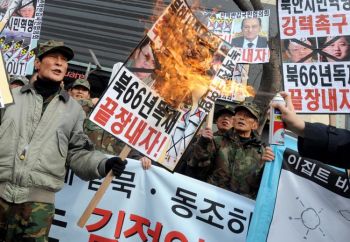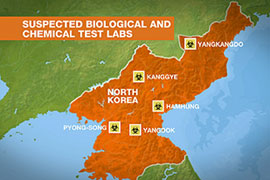From the China Information Website
Victims of Communism - North Korea

See Also: The Voice of the Martyrs in North Korea
13/12/2017
NORTH KOREA'S PRISON CAMPS
The brutality of North Korea’s government is exposed in a ground-breaking new report on the regime’s political prisons and prison camps. The Parallel Gulag: North Korea’s “An-jeon-bu” Prison Camps casts fresh light by publishing previously unseen satellite images which reveal a parallel network of prisons controlled by the North Korean Ministry of People’s Safety.
Released today by the Committee for Human Rights in North Korea (HRNK) and written by veteran human rights expert David Hawk, the report is the most comprehensive and authoritative examination of the regime’s penal system drawing on carefully sourced documentation provided by hundreds of former North Korean political prisoners and refugees now residing in South Korea. According to Hawk, “the practices documented in Parallel Gulag reveal yet another layer of North Korea’s brutal system in blatant contradiction to international laws, including treaties that North Korea has ratified.”
see the full report
17/6/2013 ESCAPING NORTH KOREA ABC TV 4 CORNERS
North Korea has been called the Hermit Kingdom and for good reason. Few people are allowed to travel in or out of the country and even fewer will talk about life inside the country where dissent is met with brutality, torture and death.
However, we do know that each year thousands of North Koreans risk their lives to escape the brutal regime that runs the country of their birth. Most of the defectors escape into China, and from there they must undertake a dangerous journey to the country's southern borders to escape into Laos, Thailand and ultimately, for many, on to South Korea.
Next on Four Corners, a startling documentary tells the story of a group of defectors that includes two young North Korean women, Sook-ja and Yong-hee. They have paid a people smuggler, who goes by the name "Dragon", to take them on the journey from northern to southern China and on to freedom.
Filmmaker Ann Shin not only tells their story; she accompanies with them undercover as they travel by bus, car and train; dodging authorities who will arrest them and send them back to North Korea. It's a dangerous trip, made all the more intense when we hear the backgrounds of the smuggler and the people he is helping.
Their perilous journey reflects the reality of tens of thousands of North Koreans currently hiding in China. Filming undercover, Ann Shin gains intimate access to these three individuals in this fly on the wall documentary, where she explores universal questions about human rights, smuggling and the pursuit of freedom.
Watch the entire report (45 mins)
21/9/2011 SATELLITE PHOTOS OF NORTH KOREA'S CONCENTRATION CAMPS
The North Korean government may deny their existence, but photos taken
from space have revealed in unprecedented detail the concentration
camps that are used imprison more than 200,000 citizens.
Men, women and children are forced to work seven days a week as slaves
and eat 'rats, frogs, snakes, insects' and even faeces to battle
starvation in the camps.
Previously there have been blurred images taken by satellite but new
detailed pictures from South Korea's Unification Ministry allow a
closer look at the sites - and also prove they have grown.
Experts say the tens of thousands of prisoners at the camps are often
taken from their homes or in the street for supposed 'political
crimes' rather than actual misdemeanours.
Half of all the inmates will die of starvation or malnutrition with
others dying because of fatal diseases that thrive in the squalid
conditions.
This is if they are not killed by torture, firing squad, or a public
stoning by Kim Jong-Il's violent guards, former prisoners say.
One of the photos shows the Yodok camp, which holds an estimated
50,000 North Korean prisoners and is hidden in the mountains around 70
miles from the capital Pyongyang.
Kang was only nine years old when he and his family were sent there
for political crimes.
'We had no food. We eat anything we could get our hands on -- rats,
snakes, frogs, insects,' he told CBN news. 'We just had to find a way
to survive.'
'Even though it happened a long time ago when I look at the satellite
pictures I can still remember everything I saw and endured,' he said.
'The camp definitely looks bigger. For example, new buildings for
prison guards weren't there before. I can only assume that means there
are more prisoners being held and therefore more security is needed.'
Kang spent 10 years in Yodok before escaping to China in 1992 and
wrote about his experiences in the book The Aquariums of Pyongyang.
It is believed he is the first prisoner to reveal to the world the
existence of Yodok..
'The thing I remember the most about in the camp is how the prison
guards would kill people for no reason. I witnessed many people being
executed,' he said.
Amnesty International has compared the satellite images to those taken
10 years ago and confirms they are growing in size and branded them
'hellish'.
'The outside world certainly doesn't know what's going on and very
little from the inside comes out,' Sam Zarifi, from Amnesty
International said last out paints a very disturbing picture.'
Scott Edwards, director of the science and human rights program at
Amnesty International added: 'The fact that we would have to rely on
satellite imagery just to dispel the government's assertion that these
camps don't exist is testament really to the scale of the human
travesty that might be going on inside.'
The news came as it was revealed the South Korean government will send
a group of religious leaders and representatives to visit North Korea
tomorrow on a peace mission.
The Unification Ministry says delegates from the Korean Conference on
Religion and Peace will leave for Pyongyang on Wednesday, where they
will discuss peace and human rights issues.
It is also understood they could meet with North Korean leader Kim Jong-il.
See the photos
27/6/21011 VIDEO SHOT SECRETLY IN NORTH LOREA SHOWS STARVATION EVEN AMONG MILITARY
Footage shot inside North Korea and obtained by the ABC has revealed the extent of chronic food shortages and malnutrition inside the secretive state.
The video is some of the most revealing footage ever smuggled out of the impoverished North Korean state.
Shot over several months by an undercover North Korean journalist, the harrowing footage shows images of filthy, homeless and orphaned children begging for food and soldiers demanding bribes.
The footage also shows North Koreans labouring on a private railway track for the dictator's son and heir near the capital Pyongyang.
Strolling up to the site supervisor, the man with the hidden camera asks what is going on.
"This rail line is a present from Kim Jong-il to comrade Kim Jong-un," he is told.
The well-fed Kim Jong-un could soon be ruling over a nation of starving, impoverished serfs.
The video shows young children caked in filth begging in markets, pleading for scraps from compatriots who have nothing to give.
watch the video
21/6/2011 NORTH KOREA HAS TRAINED 3000 CYBERHACKERS TO ATTACK WEST
Speaking via Skype, Kim told Al Jazeera that, as of last year, North Korea has procured more than 3,000 hackers serving in the North and abroad in China, Russia and elsewhere.... Following an expedited two-year programme at university, students are sent to China or Russia for about one year to solidify their knowledge of hacking and and other technical skills. After the overseas training, they are placed in various warfare units to serve as "cyberwarriors", Kim said.
Originally published in Aljazeera
4/5/2011 200000 IN CONCENTRATION CAMPS IN COMMUNIST NORTH KOREA
Amnesty International says new satellite images and testimony from a former inmate show North Korea is holding around 200,000 people in its huge network of political prison camps where torture is rampant and conditions near slavery.
The human rights group based in London released on Wednesday recent satellite photos which show four of six camps located in the impoverished country's South Pyongan, South Hamkyung and North Hamkyung provinces.
Originally published in Aljazeera
1/3/2011 DOMINO EFFECT - MIDDLE EAST PROTESTS SPUR DEMONSTRATIONS IN NORTH KOREA
On the night of Feb. 14, residents of Jongju, Yongchon, and Sonchon
Counties in Pyongan Province protested in the streets. They shouted,
“Give us electricity, give us rice!” Apparently the electricity had
been cut short and transferred to Pyongyang for Kim Jong Il’s birthday
celebration.

Anti-communist protest in Seoul
On Feb. 18, hundreds of people clashed with security forces in the
Sinuiju, on the border with China, where police
officers are said to have beaten a trader unconscious.
The military was called to quell the demonstration, leaving a number
of protesters wounded, with four or five people rumored to have been
killed.
In Chongjin in North Hamgyong Province, a group of angry residents
stoned the city’s chief security officer to death on Feb. 23, South
Korea’s Yonhap News reported on Feb. 24.
Kim Jong Il ordered severe protest control. The People’s Safety
Ministry in each area has begun organizing riot squads of around 100
people and is tracking down any sign of unrest, the Daily NK said on
Feb. 24.
originally published in The Epoch Time>
2/3/2011 NORTH KOREA TESTS BIOLOGICAL WEAPONS ON HANDICAPPED CHILDREN
When Im Chun-yong made his daring escape from North Korea, with a handful of his special forces men, there were many reasons why the North Korean government was intent on stopping them.
They were, after all, part of Kim Jong-il's elite commandos - privy to a wealth of military secrets and insights into the workings of the reclusive regime.

But among the accounts they carried with them is one of the most shocking yet to emerge - namely the use of humans, specifically mentally or physically handicapped children, to test North Korea's biological and chemical weapons.
"If you are born mentally or physically deficient, says Im, the government says your best contribution to society… is as a guinea pig for biological and chemical weapons testing."
Originally published in Aljazeera


